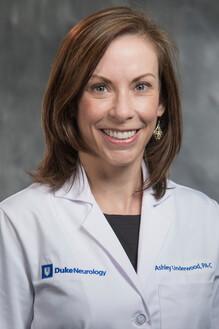
When Ashley Underwood, PA-C, MMS, joined our providers at our Morreene Road Clinic this summer, it was both a return to a previous role in headache management and an evolution of her work treating patients at Duke Pain Medicine. In this week’s “Spotlight” interview, Underwood talks to us about how her work and her patients’ needs in each of these settings compare. She also discusses managing rather than “fixing” complex head and facial pain, modeling good exercise habits for her patients, and looking forward to visiting the Grand Canyon and Eastern Europe once travel becomes safe again.
What are your current responsibilities within the Neurology Department? What does a typical day look like for you?
I work as a physician assistant in the Headache Division of the Neurology Department. I manage patients with headaches and facial pain. This involves prescribing various medications for headaches and performing procedures such as Botox, occipital nerve blocks and trigger point injections. I typically see two new patients each day and return patients every 30 minutes.
This summer you returned to treating patients with headache and facial pain after working in the Duke Pain Clinic for several years. How do these two disciplines and patient groups compare to each other? What’s the biggest difference between their needs or how you provide care?
There is certainly some overlap and I continued seeing some patients with chronic headaches while working in the pain clinic because I enjoy that patient population. Patients with refractory headaches or facial pain are often referred to the pain clinic for opioid management or more complex procedures that aren’t done by Neurology.
While working in Pain Medicine, I also managed a wide variety of other pain conditions in addition to headaches. Many of my patients were very complex because they had several pain conditions, were on high doses of opioids or had psychiatric comorbidities. My focus was on pharmacologic management of pain using opioids and adjunctive medications for pain. Being back in the headache clinic allows me to just focus on the patient’s headache disorder and I can give more time and attention to that specific area of their care.
You have an MMS in addition to your physician assistant degree. What did you study for that degree, and how does that knowledge inform your current work?
MMS stands for Masters of Medical Science. Most PA schools now offer a Master’s degree upon completion. When I graduated from Wake Forest PA School in 2004, it was the first year that they offered a master’s degree. We were required to do a “master’s project,” which involved additional research hours.
What’s one thing you wished more patients and their loved ones knew about head and facial pain?
Most people with any type of pain, including head and facial pain, want to know “why” they are having it and how to “fix” it. Unfortunately, there are only a small number of our patients that have an identifiable structural cause for their headaches which can be fixed. That means that most headache disorders such as migraine headaches or tension headaches are managed with medications in an effort to reduce the frequency, duration and severity of the headaches. We are very rarely able to completely stop a person’s headaches.
What are you most looking forward to once the COVID-19 pandemic is over?
Traveling! My family and I love to travel. We had to cancel a big trip out west to the Grand Canyon and a trip to Eastern Europe this year because of COVID-19.
What other passions or hobbies do you have outside of the Department?
I really enjoy exercising, which may sound strange. I run or do high intensity interval training almost every day. I love to be active and to push myself as hard as I can. I also want to model good health habits for patients. If I’m going to ask them to exercise regularly, I feel like I should too. I also love reading and going out to eat. Before COVID, we enjoyed trying out new restaurants around Durham. I am looking forward to getting back to that.